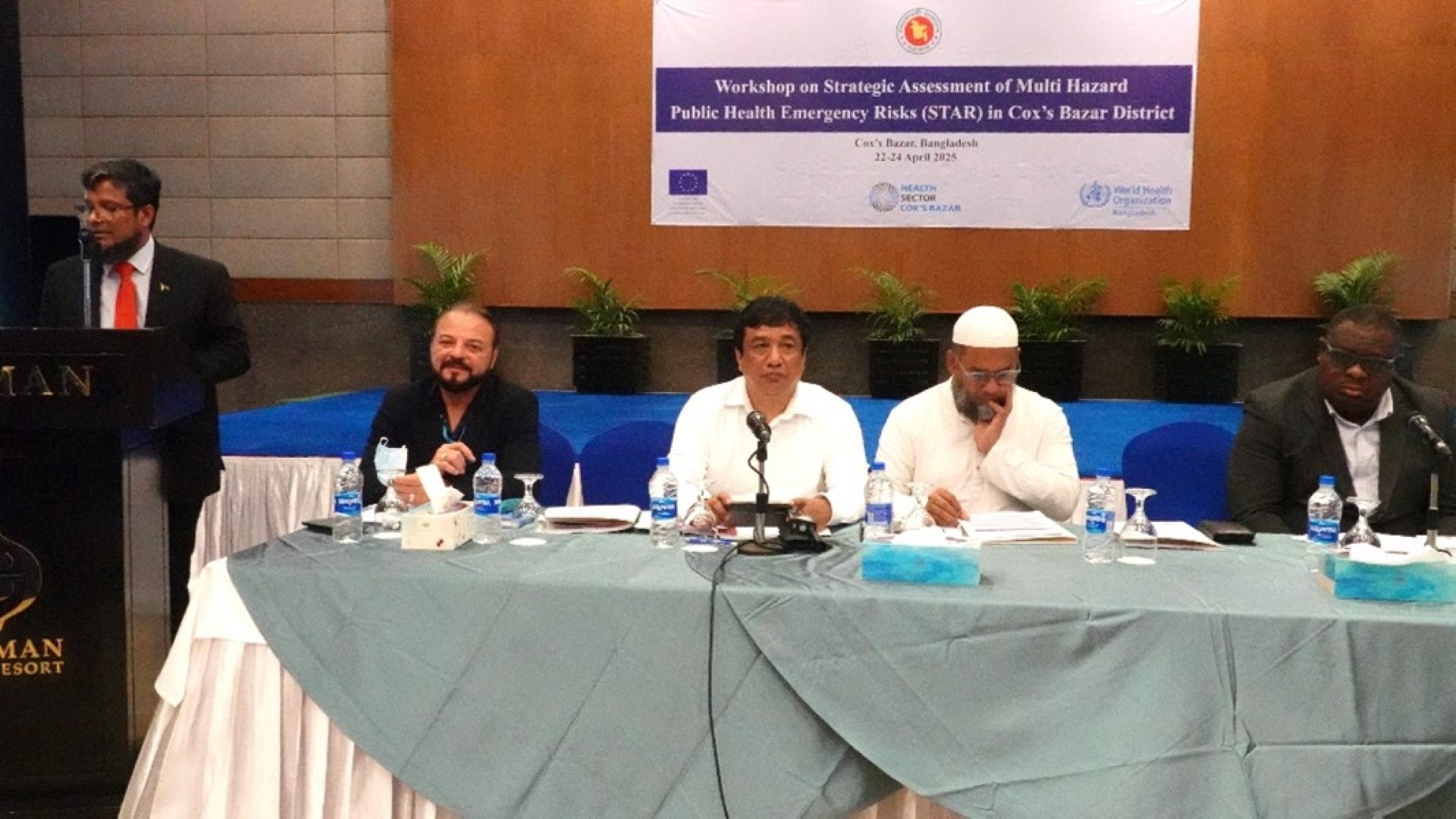Bangladesh continues to strengthen its capacity for risk-informed health emergency preparedness through the application of WHO’s Strategic Toolkit for Assessing Risks (STAR). In April 2025, two pivotal STAR workshops were held—one at the district level in Cox’s Bazar (22–24 April) and another at the national level in Dhaka (27–30 April). These workshops are key preparatory steps toward the development of Bangladesh’s next National Action Plan for Health Security (NAPHS) and updated National Health Emergency Response Operational Plan (NHEROP) following the completion of the second round JEE-IHR in June 2024
As a country highly vulnerable to different types of hazards, Bangladesh faces a complex risk landscape. Ranked 7th in the Global Climate Risk Index 2021, the country experiences frequent cyclones, floods, and infectious disease outbreaks. In Cox’s Bazar, home to over 1.15 million Rohingya Refugees and vulnerable host communities, these risks are compounded by overcrowded living conditions, poverty, and growing public health threats such as cholera, dengue, and fire-related mass casualty events.
The Cox’s Bazar district-level workshop marked a regional milestone as the first sub-national STAR implementation in the WHO South-East Asia Region. It followed a 2022 community risk perception survey and brought together 30 participants from government agencies, humanitarian organizations, and community stakeholders. Recurrent threats such as cyclones, floods, landslides, fire incidents, and disease outbreaks demand localised preparedness solutions. The STAR methodology enabled a participatory, multisectoral assessment of risks; they validated local hazards and assessed vulnerabilities, coping capacities, and seasonal trends, resulting in a validated risk matrix, seasonal calendar, and a preliminary roadmap for district-level emergency preparedness.
“This workshop is expected to generate meaningful recommendations to strengthen preparedness,” said Mr Abu Saleh Mohammed Obaidullah, Additional Secretary at the Refugee Relief and Repatriation Commissioner’s Office. “The insights gathered should guide future planning and policy decisions for Rohingya and host communities in Cox’s Bazar.

Representatives from the Government, WHO, and partner organisations in the STAR workshop in Cox’s Bazar, uniting for stronger, community-driven emergency preparedness.Credit: WHO/Terence Ngwabe Che
Participants included officials from government ministries, the Bangladesh Meteorological Department, the Department of Disaster Management, IEDCR, humanitarian agencies, and community-based organizations. They conducted contextual assessments and group exercises to assess vulnerabilities, coping capacities, and the likelihood and impact of various hazards. The highest-priority hazards identified were earthquake, cyclone, and dengue.
“This workshop reflects our collective commitment to building a safer, more resilient Cox’s Bazar,” said Dr Jorge Martinez, Head of the WHO Sub-Office in Cox’s Bazar. “By working together, we are transforming local knowledge into concrete strategies for emergency preparedness.”
At the national level, two pre-Multi-Hazard (MH) STAR sessions were convened in Dhaka, including the High-Threat Pathogen Prioritization (HTP) workshop and the review and review of the existing Infectious Hazard (IH) STAR before the MH-STAR session. The workshop sessions brought together over 40 participants from key technical departments, public health institutions, and partner organizations. Building on previous assessments, including the IH-STAR workshop held during the COVID-19 pandemic, the national-level workshop updated Bangladesh’s infectious-hazard risk profile in addition to the newly developed multi-hazard (MH) risk profile.
The STAR methodology—adapted to Bangladesh’s context—enabled a step-by-step process of hazard identification, likelihood and impact assessment, and ranking. The workshops produced a consolidated risk matrix and action plan, highlighting earthquake, cyclone, antimicrobial resistance (AMR), and flood as very high-priority hazards derived from the multi-hazard (MH) workshop; and cholera, dengue and nipah as very high-priority infectious hazards (IH) derived from the review of the tailored STAR-IH workshop. These results will directly feed into the development of NAPHS and NHEROP.

Participants collaborate in group exercises, mapping risks and shaping local strategies for stronger emergency preparedness, Dhaka, Bangladesh. Credit: WHO Bangladesh
“While the STAR tool is traditionally applied at the national level, Cox’s Bazar’s unique challenges necessitate a more localised approach,” said Dr Anthony Eshofonie, WHO Emergency Preparedness and Response Lead in Bangladesh. “Amid global funding constraints, this method enables us to prioritise risks and plan more effectively to protect vulnerable populations.”
The STAR workshops emphasized a whole-of-society approach, engaging experts from health, animal health, disaster management, water and sanitation, environmental science, and civil protection sectors. The combination of local knowledge and scientific analysis has ensured that the resulting plans are realistic, inclusive, and context driven.
“The successful implementation of the STAR tool at the district level marks a significant milestone in advancing health emergency preparedness,” said Dr Jamsheed Mohamed, WHO Representative a.i. to Bangladesh. “This initiative underscores WHO’s commitment to supporting the Government of Bangladesh in building resilient health systems that can effectively respond to local challenges. By leveraging local knowledge and fostering multisectoral collaboration, we are paving the way for more risk-informed planning across the South-East Asia Region.”
Next Steps
WHO will support the Government of Bangladesh in:
- Cascading STAR risk profiling to other high-risk districts,
- Integrating outcomes into national policies, including NAPHS and NHEROP,
- Institutionalizing the STAR and HTP processes for regular strategic risk assessment.
Through these efforts, Bangladesh is advancing toward a more resilient, risk-informed, and locally empowered health emergency preparedness system.
